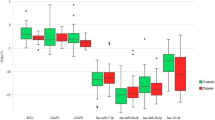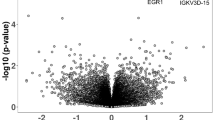Abstract
Autism spectrum disorder (ASD) is characterized by repetitive stereotypic behaviors, restricted interests, social withdrawal, and communication deficits. Aggression and insensitivity to pain are largely unexplained in these cases. We analyzed nine mRNA expressions of the candidate genes related to aggression and insensitivity to pain in the peripheral blood of patients with ASD. Whole blood samples were obtained from 40 autistic patients (33 boys, 7 girls) and 50 age- and sex-matched controls (37 boys and 13 girls) to isolate RNA. Gene expression was assessed by quantitative Real-Time PCR (qRT-PCR) in the Erciyes University Genome and Stem Cell Center (GENKOK). All of the gene expressions except CRHR1 and SLC6A4 were found to be statistically different between the ASD patients and controls. Gene expression also differed according to gender. Alterations in the mRNA expression patterns of the HTR1E, OPRL1, OPRM1, TACR1, PRKG1, SCN9A and DRD4 genes provide further evidence for a relevant effect of the respective candidate genes on the pathophysiology of ASD. Future studies may determine the sensitivity of these candidate markers in larger samples including further neuropsychiatric diagnosis.

Similar content being viewed by others
References
Allely CS (2013) Pain sensitivity and observer perception of pain in individuals with autistic spectrum disorder. Sci World J 2013:916178
Becker JA, Clesse D, Spiegelhalter C et al (2014) Autistic-like syndrome in mu opioid receptor null mice is relieved by facilitated mGluR4 activity. Neuropsychopharmacology 39(9):2049–2060
Benson BA, Brooks WT (2008) Aggressive challenging behavior and intellectual disability. Curr Opin Psychiatry 21:454–458
Bortoluzzi A, Blaya C, da Rosa ED et al (2015) What can HPA axis-linked genes tell us about anxiety disorders in adolescents? Trends Psychiatry Psychother 37(4):232–237
Bustin SA, Benes V, Garson JA et al (2009) The MIQE guidelines: minimum information for publication of quantitative real-time PCR experiments. Clin Chem 55(4):611–622
Coutinho AM, Sousa I, Martins M et al (2007) Evidence for epistasis between SLC6A4 and ITGB3 in autism etiology and in the determination of platelet serotonin levels. Hum Genet 121(2):243–256
Dominick KC, Davis NO, Lainhart J et al (2007) Atypical behaviors in children with autism and children with a history of language impairment. Res Dev Disabil 28:145–162
Elwin M, Ek L, Schroder A, Kjellin L (2012) Autobiographical accounts of sensing in Asperger syndrome and high-functioning autism. Arch Psychiatr Nurs 26:420–429
Emanuele E, Boso M, Cassola F et al (2010) Increased dopamine DRD4 receptor mRNA expression in lymphocytes of musicians and autistic individuals: bridging the music-autism connection. Neuro Endocrinol Lett 31(1):122–125
Evans JD (1996) Straight forward statistics for the behavioral sciences. Brooks/Cole Publishing, Pacific Grove
Farmer CA, Aman MG (2010) Psychometric properties of the children's scale of hostility and aggression: reactive/proactive (c-sharp). Res Dev Disabil 31:270–280
Furniss F, Biswas AB (2012) Recent research on aetiology, development and phenomenology of self-injurious behaviour in people with intellectual disabilities: a systematic review and implications for treatment. J Intellect Disabil Res 56:453–475
Gadow KD, Devincent CJ, Olvet DM et al (2010) Association of DRD4 polymorphism with severity of oppositional defiant disorder, separation anxiety disorder and repetitive behaviors in children with autism spectrum disorder. Eur J Neurosci 32(6):1058–1065
Geier DA, Kern JK, Geier MR (2013) A comparison of the autism treatment evaluation checklist (ATEC) and the childhood autism rating scale (CARS) for the quantitative evaluation of autism. J Ment Health Res Intellect Disabil 6(4):255–267
Gizer IR, Ficks C, Waldman ID (2009) Candidate gene studies of ADHD: a meta-analytic review. Hum Genet 126(1):51–90
Holden B, Gitlesen JP (2006) A total population study of challenging behavior in the county of Hedmark, Norway: prevalence, and risk markers. Res Dev Dis 27:456–465
Huang CH, Santangelo SL (2008) Autism and serotonin transporter gene polymorphisms: a systematic review and meta-analysis. Am J Med Genet B Neuropsychiatr Genet 147B(6):903–913
Kanne SM, Mazurek MO (2011) Aggression in children and adolescents with ASD: prevalence and risk factors. J Autism Dev Disord 41:926–937
Katsouni E, Sakkas P, Zarros A et al (2009) The involvement of substance P in the induction of aggressive behavior. Peptides 30(8):1586–1591
Kepser LJ, Homberg JR (2015) The neurodevelopmental effects of serotonin: a behavioural perspective. Behav Brain Res 277:3–13
Koishi S, Yamamoto K, Matsumoto H et al (2006) Serotonin transporter gene promoter polymorphism and autism: a family-based genetic association study in Japanese population. Brain Dev 28(4):257–260
Lecavalier L (2006) Behavioral and emotional problems in young people with pervasive developmental disorders: relative prevalence, effects of subject characteristics, and empirical classification. J Autism Dev Disord 36:1101–1114
Longo D, Schüler-Faccini L, Brandalize AP et al (2009) Influence of the 5-HTTLPR polymorphism and environmental risk factors in a Brazilian sample of patients with autism spectrum disorders. Brain Res 1267:9–17
MacLean WE, Tervo RC, Hoch J et al (2010) Self-injury among a community cohort of young children at risk for intellectual and developmental disabilities. J Pediatr 157:979–983
Mazurek MO, Kanne SM, Wodka EL (2013) Physical aggression in children and adolescents with autism spectrum disorders. Res Autism Spectr Disord 7:455–465
Meijer IA, Vanasse M, Nizard S et al (2014) An atypical case of SCN9A mutation presenting with global motor delay and a severe pain disorder. Muscle Nerve 49(1):134–138
Miceli S, Negwer M, van Eijs F et al (2013) High serotonin levels during brain development alter the structural input-output connectivity of neural networks in the rat somatosensory layer IV. Front Cell Neurosci 7:88
Mieres AC, Smallwood V, Nicholson SK (2011) Retrospective case report: evaluation of pain in a child with pervasive developmental disorder. Pediatr Phys Ther 23:194–200
Moore DJ (2015) Acute pain experience in individuals with autism spectrum disorders: a review. Autism 19:387–399
Oades RD, Lasky-Su J, Christiansen H et al (2008) The influence of serotonin- and other genes on impulsive behavioral aggression and cognitive impulsivity in children with attention-deficit/hyperactivity disorder (adhd): findings from a family-based association test (fbat) analysis. Behav Brain Funct 4:48
Provasi D (2015) Computational structural biology of opioid receptors. Methods Mol Biol 1230:13–38
Ressler KJ, Bradley B, Mercer KB et al (2010) Polymorphisms in CRHR1 and the serotonin transporter loci: gene x gene x environment interactions on depressive symptoms. Am J Med Genet B Neuropsychiatr Genet 153B(3):812–824
Riquelme I, Hatem SM, Montoya P (2018) Reduction of pain sensitivity after somatosensory therapy in children with autism spectrum disorders. J Abnorm Child Psychol. https://doi.org/10.1007/s10802-017-0390-6
Ro M, Won S, Kang H et al (2013) Association of the FGA and SLC6A4 genes with autistic spectrum disorder in a Korean population. Neuropsychobiology 68(4):212–220
Rose S, Wynne R, Frye RE et al (2015) Increased susceptibility to ethylmercury-induced mitochondrial dysfunction in a subset of autism lymphoblastoid cell lines. J Toxicol 2015:573701
Ross-Russell M, Sloan P (2005) Autoextraction in a child with autistic spectrum disorder. Br Dent J 198:473–474
Samaco RC, Mandel-Brehm C, McGraw CM, Shaw CA, McGill BE, Zoghbi HY (2012) Crh and Oprm1 mediate anxiety-related behavior and social approach in a mouse model of MECP2 duplication syndrome. Nat Genet 44(2):206–211
Sener EF, Cıkılı Uytun M, Korkmaz Bayramov K et al (2016) The roles of CC2D1A and HTR1A gene expressions in autism spectrum disorders. Metab Brain Dis 31(3):613–619
Sener EF, Sahin M, Taheri S et al (2017) A preliminary study of the genes related with aggression and insensitivity to pain in the autism spectrum disorders. Psychiatry Clin Psychopharmacol 27(1):24–29
Shoval G, Bar-Shira O, Zalsman G et al (2014) Transitions in the transcriptome of the serotonergic and dopaminergic systems in the human brain during adolescence. Eur Neuropsychopharmacol 24(7):1123–1132
Smith KR, Matson JL (2010) Behavior problems: differences among intellectually disabled adults with co-morbid autism spectrum disorders and epilepsy. Res Dev Disabil 31:1062–1069
Spratt EG, Granholm AC, Carpenter LA et al (2015) Pilot study and review: physiological differences in BDNF, a potential biomarker in males and females with autistic disorder. Int Neuropsychiatr Dis J 3(1):19–26
Steinhoff MS, von Mentzer B, Geppetti P et al (2014) Tachykinins and their receptors: contributions to physiological control and the mechanisms of disease. Physiol Rev 94:265–301
Taurines R, Grünblatt E, Schecklmann M et al (2011) Altered mRNA expression of monoaminergic candidate genes in the blood of children with attention deficit hyperactivity disorder and autism spectrum disorder. World J Biol Psychiatry 12(Suppl 1):104–108
Tordjman S, Anderson GM, Botbol M et al (2009) Pain reactivity and plasma beta-endorphin in children and adolescents with autistic disorder. PLoS One 4(8):e5289
Totsika V, Hastings RP, Emerson E et al (2011) A population-based investigation of behavioural and emotional problems and maternal mental health: associations with autism spectrum disorder and intellectual disability. J Child Psychol Psychiatry 52:91–99
Turecki G, Sequeira A, Gingras Y, Séguin M, Lesage A, Tousignant M et al (2003) Suicide and serotonin: study of variation at seven serotonin receptor genes in suicide completers. Am J Med Genet Part B Neuropsychiat Genet 118B:36–40
Valencia AV, Páez AL, Sampedro ME et al (2012) Evidence for association and epistasis between the genetic markers SLC6A4 and HTR2A in autism etiology. Biomedica 32(4):585–601
Waye MMY, Cheng HY (2018) Genetics and epigenetics of autism. Psychiatry Clin Neurosci 72(4):228–244
Whyte A, Jessen T, Varney S, Carneiro AM (2014) Serotonin transporter and integrin beta 3 genes interact to modulate serotonin uptake in mouse brain. Neurochem Int 73:122–126
Woodbury-Smith M, Scherer SW (2018) Progress in the genetics of autism spectrum disorder. Dev Med Child Neurol 60(5):445–451
Zhao Z, Webb BT, Jia P, International Schizophrenia Consortium, Riley BP, Kendler KS, Fanous AH et al (2013) Association study of 167 candidate genes for schizophrenia selected by a multi-domain evidence-based prioritization algorithm and neurodevelopmental hypothesis. PLoS One 8(7):e67776
Acknowledgements
This study has been supported by a grant (Project Number: 114S742) from The Scientific & Technological Research Council (TUBITAK) of Turkey.
Author information
Authors and Affiliations
Corresponding author
Ethics declarations
Conflict of Interest
The authors have no conflicts of interest or other disclosures to report.
Additional information
Publisher’s Note
Springer Nature remains neutral with regard to jurisdictional claims in published maps and institutional affiliations.
Rights and permissions
About this article
Cite this article
Sener, E.F., Taheri, S., Sahin, M.C. et al. Altered Global mRNA Expressions of Pain and Aggression Related Genes in the Blood of Children with Autism Spectrum Disorders. J Mol Neurosci 67, 89–96 (2019). https://doi.org/10.1007/s12031-018-1213-0
Received:
Accepted:
Published:
Issue Date:
DOI: https://doi.org/10.1007/s12031-018-1213-0




